what do i need to raise baby chicks
Raising Babe Chickens—The Showtime lx Days
Getting and raising chicks is exciting and may fifty-fifty be a little nerve-wracking time for backyard chicken keepers. In that location are a few bones, just very of import, things you lot tin and should do to make this rewarding experience as hassle-complimentary and enjoyable equally possible for yourself and the little ones. First off, let'south start with the…
The Brooder
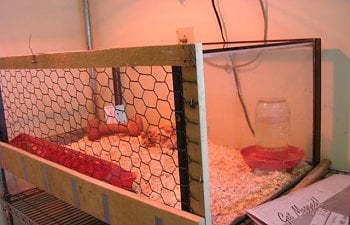
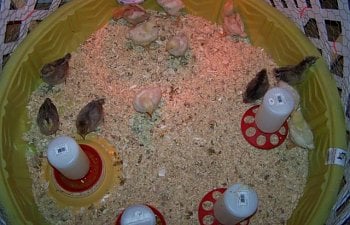
If you decided to hatch the fertile eggs in an Incubator rather than under mother hens, and then the chick's get-go domicile will be the brooder. (The all-time start to finding out more about brooder designs and ideas see our Incubators & Brooders section for lots of valuable information) The size of the brooder will depend on the number of chicks yous have. Aim for at to the lowest degree 2.5 sq feet per chick, if possible, more is better. Overcrowding chicks can cause a host of bug and they will grow so fast, what seems very generous space-wise at present will chop-chop get filled up!
The bottom of the brooder should take a layer of clean litter (pine shavings or similar is platonic only NOT cedar shavings). Do Non line the bottom with paper or similar. Newspaper is slippery underfoot and can cause foot and leg bug in the chicks as a result. For very small-scale chicks newspaper towels over woods shavings are recommended. This will stop them from pecking at and eating the shavings while they figure out what "food" is. The litter should exist inverse out every couple of days, and never allowed to remain damp—cleanliness is VERY important at this phase. Infant chicks are prone to a number of diseases, such as Coccidiosis, which thrives in a damp environment. This and other chick health problems can exist avoided with proper sanitation.
When the chicks are effectually a month old, add together a depression roost near 4" off the floor of the brooder to encourage the chicks to start roosting. Don't put information technology directly under the heat lamp, it will exist besides warm there.
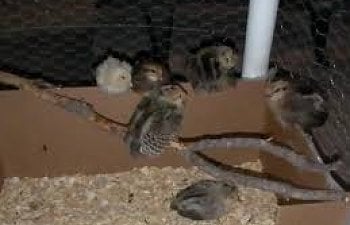
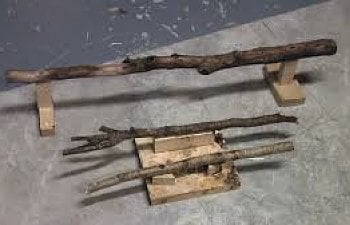
The Temperature in the Brooder
The brooder tin can exist heated by using a light bulb with a reflector, available at any hardware shop. A 100-watt bulb is usually fine, though most people use an actual heat lamp. The temperature should be around 90*F degrees for the outset week in the warmest role of the brooder and should be reduced by around 5 degrees each week thereafter until the chicks have their feathers (5-viii weeks old). It's important that you provide warmer and cooler areas in the brooder, so the chicks can move effectually and regulate their trunk temperatures as they feel comfortable.
A thermometer in the brooder is helpful, merely you can tell if the temperature is correct by how the chicks bear. If they are panting and/or huddling in corners farthest from the calorie-free, they are too hot. If they huddle together in a ball nether the light, they are too cold. Y'all tin can adjust the distance of the light (or modify the wattage of the bulb) until the warmth is just right.
It is important that you make sure yous use the correct estrus seedling for your brooder. Teflon-coated bulbs can exist fatal, as this member learned: Seven dead hens within 4 hours, not attacked. UPDATE: Teflon Poisoning!
Food and Water for the Chicks
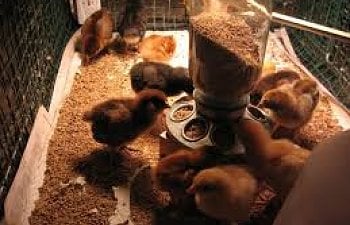
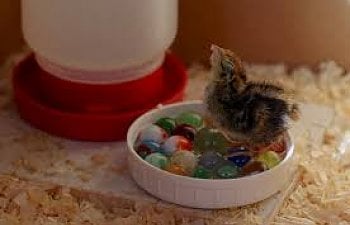
Make sure yous always take fresh, make clean water available for your chicks. Place the waterer as far as possible abroad from the heat lamp, and if you lot are using a basin, make full information technology with marbles or clean pebbles to assist forestall the chicks from drowning or getting soaked if they accidentally autumn in. Chicks are clumsy lilliputian things and landing in the water bowl is an inevitable part of growing upwards for them, with often fatal results.
Even infant chicks will naturally scratch at their nutrient, so a feeder that (more or less) keeps the nutrient in ane place is practiced. Again, cleanliness is of import: the chicks volition poop right into their own food, so yous must make clean and remove feces and refill it frequently. Chicks start out with food called "crumbles", or "chick starter feed" easily available at your local feed shop). It is specially formulated for their dietary needs and it comes as medicated or non.
Medicated feed is usually medicated with a small corporeality of Amprolium drugs, which helps forestall Coccidiosis. Please notation: you lot still need to be mindful of cleanliness in the brooder, fifty-fifty if you feed the medicated starter. Like the influenza jab, it's not 100% prevention. Chick feed is a complete nutrient with enough nutrients for them — no other food is necessary. However, afterward the first week or two, you lot tin give them small amounts of treats every day equally part of a varied nutrition.
Remember when feeding treats to offer the chicks grit to help them break down the new food. If you cannot find chick grit, coarse sand works just also. Here are some ideas for skillful treats for babe chicks. Though feeding treats is great fun and they probably volition dearest the taste, it should be regarded as candy to humans and fed in moderation to ensure a healthy flock.
Play Time
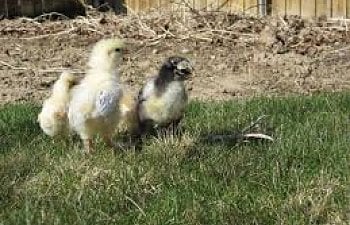
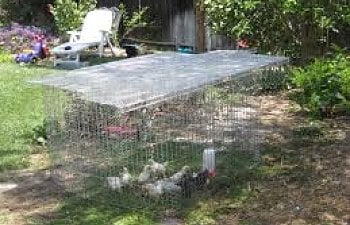
Chicks are insatiably curious—subsequently the first week or two, they can be put exterior for curt periods of fourth dimension if the temperature is high enough. They MUST exist watched at this historic period, notwithstanding. Chicks tin can move fast, squeeze into minor spaces, and are helpless against a variety of predators, including the family unit dog or true cat. They are also astonishing escape artists, so make sure they are in a secure enclosure!
If they have bonded to yous, they are likely follow you lot around. Chickens become addicted of their owners, some will come when you telephone call them (and some won't!). Proceed outside time short for the first few days, while the chicks get used to the thought, and gradually extend the time they spend outdoors every bit they grow upwardly. This volition eventually brand the transition to the chicken coop easier for you and them besides.
Keeping Chicks Healthy
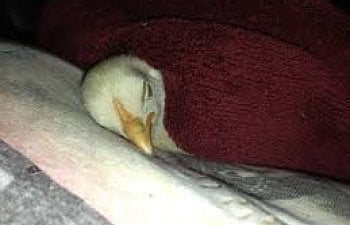
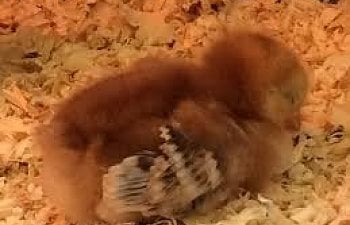
Chicks are prone to a condition called "mucilaginous butt" where droppings stick to their vents and clog information technology up, making it impossible for them to relieve themselves. If left untreated this can kill your feathered friends. Check your chicks' bottoms every few hours, especially during the kickoff 2 weeks. If you notice a viscid lesser carefully soak and remove the plug, pat the surface area and dry and apply a little Vaseline or vegetable oil to the area. Organic ACV (apple cider vinegar) in their beverage water is plant to assistance forestall this condition. A ratio of 3–4 tablespoons to a gallon of water is recommended.
Seeing your chicks grow from mean solar day-olds to pullets and cockerels and so to adult birds is very rewarding. But to a higher place I've shared some good tips to ensure yous accept a healthy flock.
For more on raising chicks see the Raising Babe Chicks section of the forum.
Source: https://www.backyardchickens.com/articles/how-to-raise-baby-chicks-the-first-60-days-of-raising-baby-chickens.47691/
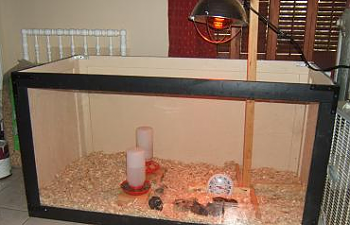
0 Response to "what do i need to raise baby chicks"
Post a Comment